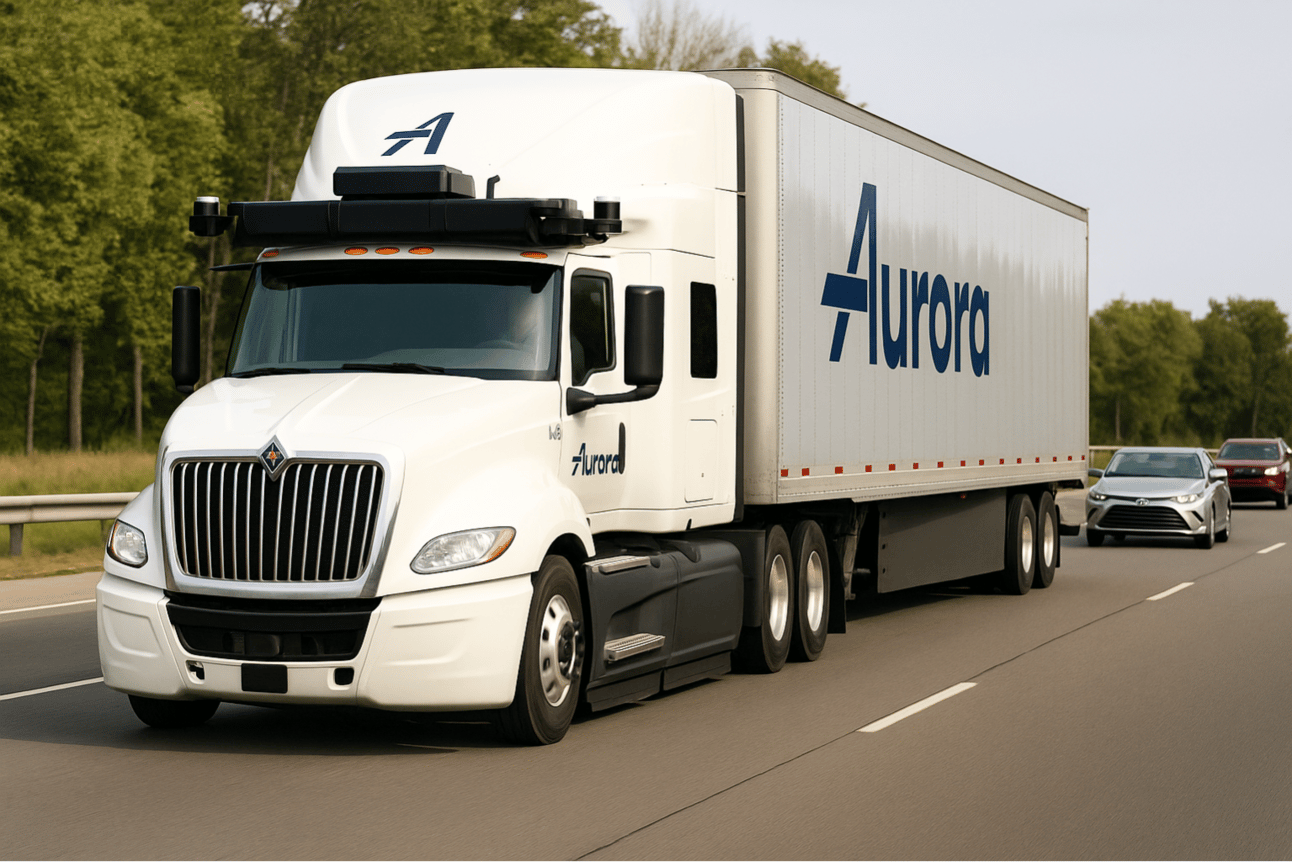
Image Source: ChatGPT-4o
Aurora Expands Driverless Trucking With Night Driving and New Routes
Aurora Innovation plans to expand its autonomous freight network in the second half of 2025, introducing night driving and broader regional coverage as it builds on the launch of its first fully driverless commercial operations.
The autonomous vehicle company shared the update Thursday in its first-quarter shareholder letter and earnings call. Aurora said it will begin operating its self-driving trucks at night and in challenging weather conditions, including rain and strong winds. New driverless routes will extend beyond the Dallas–Houston corridor to El Paso and Phoenix.
“We should be able to double our drive time as soon as we unlock night,” said Aurora CFO Dave Maday. “That’s our next key milestone.”
From Launch to Expansion
Aurora’s first driverless freight runs began earlier this month, with trucks operating between Dallas and Houston for launch customers Hirschbach Motor Lines and Uber Freight. Those runs are currently being handled by two fully autonomous trucks operating daily without a human driver on a daily basis.
The company says its vehicles have already completed more than 4,000 driverless miles with freight cargo, and it expects to scale that effort significantly. By the end of 2025, Aurora aims to be running “tens of trucks” in regular commercial service.
While night and weather conditions have already been tested in vehicles with safety operators on board, the 2025 expansion marks the first time those conditions will be handled without a human fallback.
“We’d like to have a high return on asset for every truck that we have,” Maday said. “We’ll try to drive efficiency to get as many miles on as many trucks as fast as possible.”
Revenue Grows Ahead of Driverless Scale
In Q1, Aurora generated $871,000 in pilot revenue from freight runs that still included a human operator—a 22% increase over the previous quarter and 54% higher than the same period last year.
Maday said the company expects its full driverless launch to unlock additional revenue streams, though early totals will remain relatively small.
“We expect our 2025 revenue to be modest, in the mid-single-digit millions,” he said. “For modeling purposes, we expect revenue to build sequentially throughout the year.”
Aurora expects to report revenue from both driverless and pilot freight operations as it scales.
Long-Term Strategy: Driver-as-a-Service
For now, Aurora plans to own, operate, and insure its trucks directly for carrier partners—including those on the Uber Freight platform. But that’s a temporary model.
Starting in 2027 or earlier, the company plans to transition to a driver-as-a-service model. Aurora is working with commercial vehicle partners Paccar and Volvo Trucks to produce autonomous-ready trucks at scale. Under this model, carriers would purchase trucks directly from manufacturers, while Aurora would provide the AI driver system as a service layer—aiming for higher margins and lower operating costs.
Financial Outlook and Organizational Change
Aurora reported $211 million in total operating expenses for Q1, including $153 million in research and development. It used $142 million in operating cash and $8 million in capital expenditures, ending the quarter with nearly $1.2 billion in cash and short-term investments. The company expects to spend between $175 million and $185 million per quarter for the rest of 2025.
The update also comes as Sterling Anderson, Aurora’s co-founder and chief product officer, steps down from his role. While the company did not provide details on the leadership change, it continues to emphasize a deliberate, milestone-driven path toward scaled driverless freight.
What This Means
Aurora’s steady rollout strategy suggests a measured but confident approach to deploying fully autonomous trucking at scale. By adding night driving and weather tolerance, the company is tackling some of the biggest remaining variables in long-haul automation. Its plan to expand westward while transitioning to a service model signals long-term ambitions beyond one-off pilot runs or tech demos.
Driverless freight also introduces a fundamental shift in logistics efficiency. Without the legal and physical constraints of human drivers—like mandated rest breaks or limited shift hours—autonomous trucks can operate nearly continuously. That has the potential to reduce delivery times, ease supply chain bottlenecks, and make long-haul freight more resilient during periods of labor shortage or disruption.
As regulators, partners, and customers weigh the readiness of driverless freight, Aurora’s performance in these next phases could help set the tone for how autonomous trucking enters the commercial mainstream.
If Aurora delivers on its vision, driverless freight won’t just change how goods move—it could redefine the pace, cost, and reliability of supply chains across the U.S.
Editor’s Note: This article was created by Alicia Shapiro, CMO of AiNews.com, with writing, image, and idea-generation support from ChatGPT, an AI assistant. However, the final perspective and editorial choices are solely Alicia Shapiro’s. Special thanks to ChatGPT for assistance with research and editorial support in crafting this article.
